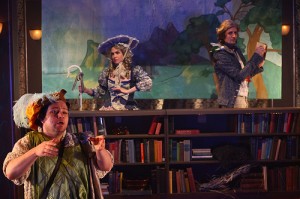THEATER AS A COLLECTIVE DREAM
The band is already playing, the show underway, as we enter The Kitchen Theatre by way of the stage, which is set up like the parlor of a mystic or a fortuneteller, full of old books and odd, antiquated objects. As we take our seats we are offered wine from silvery bladders by a stocky, raffish fellow in a burgundy blazer (Matt Kalman). He is playing the host for the moment, before the “real” show begins. But he will play many parts, as will the rest of the cast, in The National Theater of the United States of America’s wonderfully inventive new show, The Golden Veil, written by Normandy Raven Sherwood.
The actors play minstrels (troubadours, songsters, etc.) performing a dark fairy tale about a shepherdess and an inventor, called The Golden Veil (joining Mr. Kalman are Jesse Hawley, Ean Sheehy, Maggie Robinson, as well as Tavish Miller and Ms. Sherwood as the two silent stagehands/extras). The way in which the story is told, however, is so theatrically unique that it almost defies description. We are both a modern audience and one within a different time and place altogether. This conceit makes us both spectators of and participants in the performance. If this sounds similar to being in a dream, that’s precisely what The Golden Veil is like, and the result will lift your spirits from the darkest of moods.
Sherwood’s book reads like a seductive riddle, and in her dream world, imaginatively directed by James Stanley, anything goes: One actor plays a minstrel playing a queen playing a shepherdess; peasants eat bear soup (ingredients: a rabbit, a thrush and a small bear); 17th century cavaliers at a ball wear painted cardboard cutouts reminiscent of a carnival’s novelty photo-booth; and when a wedding cake is called for, a player in an animal mask shows us his ass, then, moments later, engages in a cannibalistic orgy (as I said, it defies description). There is even a side story which gets told in pantomime, where the main characters are a mini-banana and a lemon!
Alternating from whimsical to enigmatic to poetic to sinister, this dream world is masterfully realized through a blend of resourceful performances, expressive lighting (Ben Kato, Cooper Gardner), inspired sound design (Jody Elff), hauntingly beautiful music (Nick Demopoulos) and original songs (Jesse Hawley). The collaborative set design – with its intentionally amateurish elements (painted scenery backdrops jerkily raised and lowered, Punch-and-Judy-style puppets) – make our connection to what we are watching all the more intimate. It’s as if the show were being put on for us by a group of impish children in a private theater at their home, which makes the dream experience – and more important, the storytelling – even more potent.
 Within this show-within-a-show-within-a-show context, there aren’t any “real” characters in peril, which has the potential of creating an emotional disconnect between the audience and the events on stage. Peter Greenaway, in his film The Baby of Macon, which is about a play, solves this problem by having the real, horrific tragedy happen not only to the characters in the play but also to the actors portraying them. This does not happen in The Golden Veil, and I feared that the consistent playacting would cause the show to degenerate into merely clever kitsch. Thankfully, it never does. While I can’t help but wonder what the emotional impact of this effective and delightful show might have been had an additional layer of the minstrels’ reality been explored, The Golden Veil nonetheless achieves an extraordinary depth of feeling, created not so much by logic as it is with sheer theatricality – and that is an amazing feat.
Within this show-within-a-show-within-a-show context, there aren’t any “real” characters in peril, which has the potential of creating an emotional disconnect between the audience and the events on stage. Peter Greenaway, in his film The Baby of Macon, which is about a play, solves this problem by having the real, horrific tragedy happen not only to the characters in the play but also to the actors portraying them. This does not happen in The Golden Veil, and I feared that the consistent playacting would cause the show to degenerate into merely clever kitsch. Thankfully, it never does. While I can’t help but wonder what the emotional impact of this effective and delightful show might have been had an additional layer of the minstrels’ reality been explored, The Golden Veil nonetheless achieves an extraordinary depth of feeling, created not so much by logic as it is with sheer theatricality – and that is an amazing feat.
photos by Paula Court
The Golden Veil
The National Theater of the United States of America
The Kitchen, 512 W. 19th St. in Chelsea
ends on June 16, 2012
for tickets, call 212-255-5793 or visit The Kitchen




